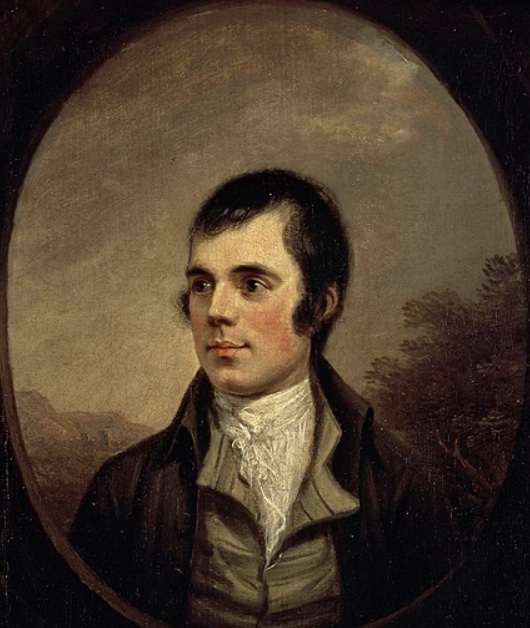
Robert Burns, known affectionately as “Rabbie Burns,” was born on January 25, 1759 in Alloway, Ayrshire, Scotland. The eldest of seven children, Robbie spent his formative years working on the Mount Oliphant farm where his parents were tenant farmers. The family was struggling against poverty and the hardship involved in squeezing a livelihood out of the land. Most of Rabbie’s early education came from his father who taught his children the 3 R’s, history and geography and from John Murdoch who ran a private school and extended the learning to Latin, French and mathematics.
In the years that followed, Rabbie and his brother Gilbert struggled to scratch a living from the farm, occasionally engaging in social events with the local community. In 1784, at age 25, Rabbie impregnated his mother’s servant, Elizabeth Paton, while courting Jean Armour, the daughter of a stone mason. The year after the birth of Elizabeth’s child, Jean bore him twins. In 1788, Rabbie and Jean were married and together they procreated nine children, six of whom died in infancy. A century earlier, philosopher Thomas Hobbes had described life as “solitary, poor, nasty, brutish and short,” and it appeared that not much had changed by the time Burn’s family appeared on the scene. Failing in his efforts to support his family from farming, he accepted an offer to work as a bookkeeper in a sugar plantation in Jamaica.
More Love affairs
Shortly before departing for Jamaica, Rabbie fell in love with Mary Campbell, a young woman whom he had met in a church they both attended. To express his love, he dedicated to her the poems “The Highland Lassie O”, “Highland Mary”, and “To Mary in Heaven.” Some historians believe that his song “Will ye go to the Indies, my Mary, And leave auld Scotia’s shore?” reveals their secret plan to travel to Jamaica together. However, a few months later, Mary contracted typhus and died.
To pay for his travel to Jamaica, Rabbie found a publisher, John Wilson who, on April 14, 1786 published Rabbie’s Scotch Poems and a few months later, published Rabbie’s Kilmarnock volume, that included such favourites as “The Two Dogs,” “The Cotter’s Saturday Night,” and “Epitaph for James Smith.” These works were an overnight success that catapulted Rabbie to the forefront of Scottish literature and enabled him to cancel his escape to Jamaica.
By November 1790, Burns had written the narrative poem “Tam O’Shanter” that many regard as his masterpiece. In 1799, his poem “Auld Lang Syne,” written in 1788, was set to an old Scottish tune and has since become the traditional piece that it is sung at the stroke of midnight every New Year’s Eve to bid farewell to the old year. On July 21, 1796, seven months after bidding farewell to 1795, Rabbie Burns succumbed to his rheumatic heart condition at the age of 37. Yet, he lives anew every year as we sing Auld Lang Syne and never forget our old acquaintance with him.
